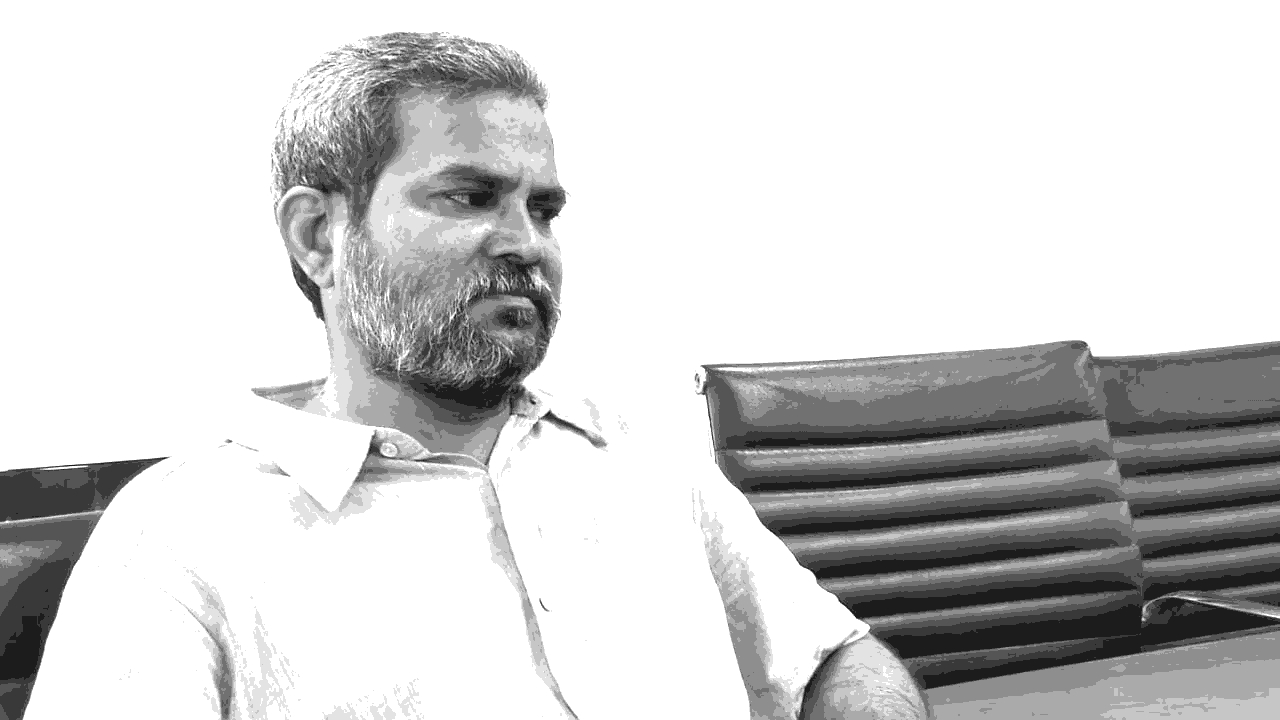Kamal Shukla is a Bastar based journalist. He is the editor of ‘Bhumkal Samachar’ newspaper, published from Kanker. Shukla also writes for several local and national news portals, and heads an organisation – the Patrakar Suraksha Kanoon Sanyukt Sangharsh Samiti – which seeks a law to protect journalists in the Bastar region. Shukla was recently charged by Chattisgarh police with sedition under Section 124A of Indian Penal Code for sharing a cartoon on Facebook that allegedly made derogatory references to the judiciary and the government. groundXero talked to Kamal Shukla about the situation in Bastar, and the state of journalism there. The original interview was conducted in Hindi. This is part one.
gX: To begin with, tell us about how you got into journalism in Bastar.
KS: The situation we see today in Bastar, is not very different from what is seen generally in Chhattisgarh or other places where there are minerals. We know that minerals are where indigenous people reside, and then you have a politics based on plundering of these resources. We know that this is a global phenomenon. But 30 years back when I started journalism, I knew nothing about any of this.
The day I first reached Bastar, I was on a State transport bus to South Bastar. I watched the behaviour of the bus conductor and non-local, non-adivasi people in the bus, towards the adivasi passengers. Even though they had bought tickets, they were being harassed in various ways – they were heckled, not allowed to sit on the seats, etc. Then when I reached Bijapur, I saw people who had come to the market — with 30-40 kgs of stuff — forest and agricultural produce. They had walked 20-25 kms, all the way from their villages. I saw their produce being looted away from them just outside of the market. This is so structural that even the looters have their own fixed rates. This made me wonder about how is it that people who are the owners of this land and it’s resources, are humiliated in such a routine way by those who are outsiders. The quest for understanding this paradox is what made me a journalist.
gX: What would be your primary impression about the past and present of journalism in Bastar?
KS: Technically I was a journalist by profession from before. When I went to Bastar in 1986-87, I was the Bureau Chief of Amrit Sandesh. Later also when I went to stay in Bastar, I worked for various weekly periodicals. I worked for a long time in Dandkaranya Samachar, one of the oldest newspapers in Bastar. So I have been observing newspaper policies since then. The one thing that hasn’t changed ever is the fact that the core issues faced by adivasis in Bastar have always been ignored by the press. Over the last 13-14 years of BJP rule specifically, the state has witnessed unfolding of an unprecedented policy-framework that aims towards structural elimination of ‘news’ itself. But as a matter of fact, before BJP, when Congress was in power in the state, it’s not as if the situation of the adivasis was much better. Through RTI queries, we figured that around 40% of all forests in Bastar had been leased out on paper to corporate interests – both private and public sector companies – 15 years back. This is in fact the context in which Chhattisgarh becomes a new state. This was Congress government at the center, and BJP at the state.
gX: Mahendra Karma (Salwa Judum leader) was himself a Congress MLA…
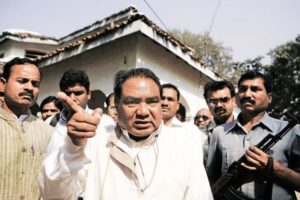
Photo: Manpreet Romana/AFP . Courtesy: Livemint
KS: Yes, Mahendra Karma was Congress leader. When the debate on 6th Schedule (protecting adivasi land and forests) started in Bastar, all other tribal leaders such as Arvind Netam, Manish Kunjam, etc., who were in favour of protecting 6th schedule lands, were politically marginalized. Mahendra Karma was propped up as ‘the’ tribal leader, and given a form of legitimacy across party-lines.
Although Bastar’s population, particularly it’s voting population, is predominantly tribal, but still Bastar politics is in the control of non-tribals. This does not depend on whether the Congress or the BJP is in power. With the only exception of perhaps CPI, no other political party in Bastar, including CPI(M), has ever created a politically aware local tribal leadership within their own parties. Every now and then when a tribal leader like Manish Kunjam, or Arvind Netam, becomes significant, they are politically attacked and marginalised. The exploitative class in Bastar has always been the non-tribals.
The only significant counter-example to this would perhaps be Mahendra Karma, who was again created mainly as an instrument for these classes. He rose to prominence as a leader of even the non-tribals in the area, because of his opposition to the 6th schedule. Even the BJP accepted and patronised his leadership. Already before joining Congress, as a CPI leader he had 500 acres of land which he had looted from other tribal families. After he led the Salwa Judum, his property swelled to 1200 acres of land. So we shouldn’t look at Mahendra Karma as an adivasi leader. He was in fact a leader of the non-tribals in Bastar.
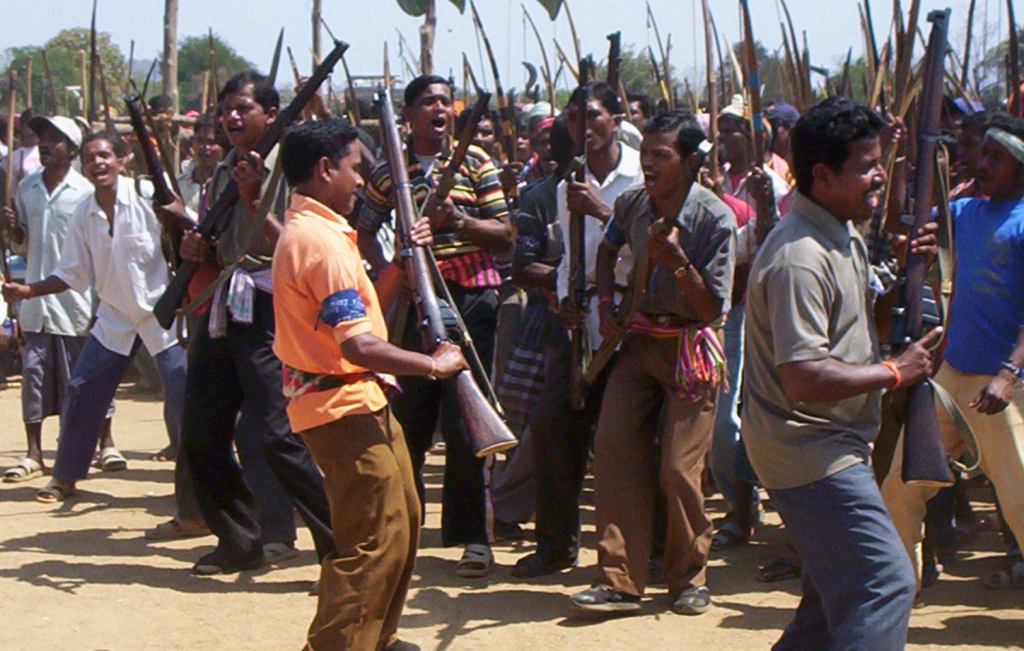
The first Salwa Judum rally in Konta, Chhattisgarh. Courtesy: The Wire
gX: Since we started talking about Mahendra Karma and 6th Schedule, tell us a bit about Salwa Judum. What did it mean for adivasis in Bastar?
KS: For the past 25-30 years, in the name of various ‘Jan Jagran Abhiyans’ – models of adivasi cleansing through arming a civilian adivasi population – have been experimented with. Salwa Judum is one of the most significant amongst them. It was started primarily to ensure land grab on behalf of the corporates. The Government says it was to counter Maoism, but that’s completely false. If you map all the villages which were attacked by Salwa Judum, you’d see how they coincide with the mining leases for the Tatas, Essar, Nicco, or even public sector corporations like Bailadila Steel Plant, etc. If you visit the office of the Bastar Superintendent of Police, there is a big map of Bastar on his wall, with numerous villages marked with red dots. These are the villages that they want to evacuate. They have put up paramilitary camps, to protect even those mines that have been operating illegally, without permission from the Gram Sabha, in complete violation of the 6th Schedule provisions, PESA act, etc. Then when these jawans protecting illegal mines get killed, the Government washes it’s hands off by declaring them as ‘martyrs’. For example, there is this Nicco mines in Abujhmad, non-operational on paper because of legal issues. Recently the Maoists allegedly burnt down Nicco’s mining vehicles. The Government and the media went up in arms. But no one asked, if there is no mining activity going on there, where did these mining trucks come from and why?
gX: Is there any new form of Salwa Judum that is going on now in Bastar?
KS: After Karma’s death, they haven’t found anyone like him to lead another Salwa Judum, so they are now working with other smaller versions of the same – such as Samajik Ekta Manch, Agni, Bastar Sangharsh Samiti, Sarv Dharm Samiti, etc. These armed vigilante groups gang up together every time the state wants to attack someone – such as what happened with Bela Bhatia – and they lead such attacks under complete political and legal impunity.
But we must note that, behind all such initiatives, it is always the non-tribals. These settlers from outside were given shelter by the tribals of Bastar, and today they rule the adivasi’s life, sitting on their heads. These are people with business interests, who live in big houses in Raipur or Delhi.
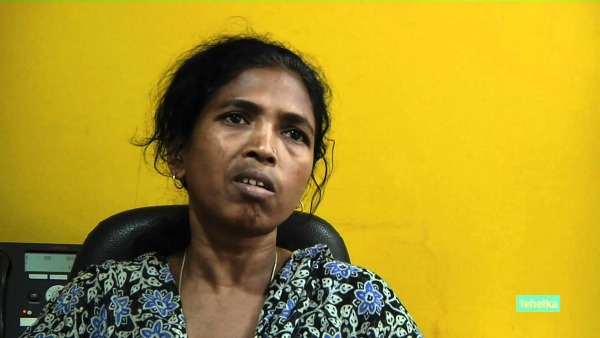
Soni Sori, activist. Courtesy: Tehelka
This is not just BJP but, Congress’s policy was no different. If you remember what happened with BD Sharma – he was stripped off his clothes, garlanded with shoes, and paraded around, when he opposed tribal land grab by corporates. This was during Congress’ rule, and those who attacked him were from both BJP and Congress. Then Medha Patkar was attacked. Then Malini Subramaniam, PV Rajagopal, Bela Bhatia, Jagdalpur Legal Aid group, and many many others were attacked with similar kind of viciousness. Today they don’t let you enter Bastar at all, you will be stopped. The police in fact informs these vigilante groups about your location. Every time I try going beyond Jagdalpur, my mobile is tracked down and I am stopped. Soni Sori’s movements have been strictly confined by the administration in the name of her “security”. You are far away, so it’s not surprising that you won’t get much news. But, even for people like us who live in Bastar, it’s almost impossible to get to know these days what is going on in the villages.
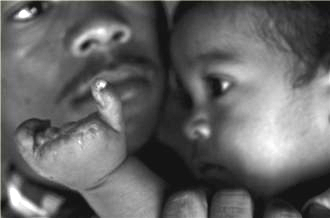
The fingers of 18-month-old Katam Suresh were cut off during an attack by government security forces on his village of Gompad, Chhattisgarh. Courtesy: Javed Iqbal
Hundreds armed forces, together with these vigilante groups, are regularly roaming about in Bastar, looting food from the villagers, killing, raping, terrorizing people. No post-mortem, no legal inquiry is happening in any of these cases. The local Hindi media has blacked out any news from these regions. Journalists who try to cover such news are removed from their jobs.
gX: You were talking about specific villages being eyed by the Government. Could you elaborate a bit more on this?
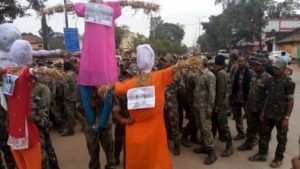
Effigies of Bela Bhatia, Himanshu Kumar, Nandini Sundar, Manish Kunjam and Malini Subramaniam held aloft by uniformed security force personnel in Bastar, Chhattisgarh, before being set on fire on Monday. Courtesy: The Wire
KS: Over the past 15 years, there are hundreds of villages, like Saonar, Gangalur (which was attacked, again, only a few days back), and others, that have been routinely and repeatedly attacked, almost once every year. Why? What is so significant about these particular villages? There are many among these villages where more than 20 people have been killed.
The villagers here have lost complete faith on the Indian state. The state has set up ration shops in these villages, but every time any villager comes to get ration, they are captured. For sometime therefore only women and children were coming, but now they have started getting attacked as well. Take for instance the case of Abujhmad. Historically, even before the BJP took over power in the state, every government service in Abujhmad was being carried out by the RamKrishna Mission there – services such as employment, health, PDS, schools, anganwadi, everything. The BJP Government claimed that these people are providing ration to the Maoists, and stopped the supplies. There wouldn’t have been more than 500 armed Maoists in Abujhmad then. Using this excuse, you can’t stop ration supplies to some 40000 people, can you? Even now there is an administrative ban on PDS in Abujhmad.
gX: Tell us a little more about the PDS situation that you were mentioning. Didn’t the CG government win awards for running the most successful PDS system in the country?
KS: Yes, let’s again talk about Abujhmad. Narayanpur was made into a district, with two blocks – Narayanpur and Orchha. There are 26 panchayats in Narayanpur, out of which 19 fall in the Abujhmad area. Of these 19 panchayats, as many as 15 panchayat offices have been set up in Orchha, far away from their actual constituencies. You will find one Panchayat office in each lane in Orchha, mentioning the village name, while the village itself is somewhere else. The Sarpanch sits here and doesn’t ever visit the village. He doesn’t even properly know where the village actually is – the village that he is the sarpanch of. Now these offices are running, PDS is running, but what does that even mean? The Collector will tell you that Abujhmad area is still unsurveyed, since independence. Many years had passed since Independence when there was no Mao or Maoism. Why wasn’t a survey done then?
Anyway, this means that people from Abujhmad must come to the Orchha market for several of their basic supplies. On these market days, the IB, SP, etc., roam around in the market and track down people coming from Abujhmad, with the help of ‘informers’. Any such person, regardless of who he or she is, is picked up and tortured in police custody for days. Information is extracted from them as much as possible, and then they are released. Once such people get back to their village, if they do at all, they are targeted by the Maoists.

Typical market day in Bijapur. Photo from 2009. Photographer: Javed Iqbal
gX: How structured is this ‘informer network’? Is the so-called ‘Bastar Battalion’ a step towards building such a well-oiled mechanism that would work for the police?
KS: Bastar battalion is a CRPF unit, comprising of young men and women from Bastar itself. From those ‘red-dotted’ villages that I mentioned earlier, thousands of young people, after surviving years of armed attack by the state forces, are now roaming around with the police and the administration. The administration promises them jobs and such, but after waiting for years when they actually get nothing from the state, some of them give up and try getting back to their villages. Then they often become targets for the Maoists, creating a very complex socio-economic situation. Many of these people would have members in their own family who are fighting on the side of the Maoists. So this is actually tearing apart families, like what happens in any civil war. Even when the British captured this country, they used armed forces constituted of Indians themselves. The Indian Government also follows the same colonial policy.
gX: Let’s talk about the civilian problems for a bit. Is the Government even looking into other fatalities the people of Bastar are facing? Other than ‘encounters’ or the Judum-style killings?
KS: Exactly. It is not as if nature has given free pass to people in Bastar, right? You won’t find data regarding even natural deaths, with the Bastar administration. It is as if floods are happening but no one is dying somehow. Deaths caused by diseases such as malaria, or food poisoning – there are no records, or no steps to counter such things. After Salwa Judum was disbanded following the Supreme Court order, many of the villages that were evacuated, resettled. The Government hasn’t still installed tube-wells in those villages. Nether have the existing old ones been serviced. Health centers and schools have been locked. More than 3000 schools across CG have been shut down.
gX: The Government says that the Maoists blast the school buildings…
KS: That’s something they used to say before, when the school buildings were permanent brick structures. The thing is, the army used to go and camp in, which is when the Maoists started blasting them up. Now they don’t say that, because for some time they have replaced the permanent brick structures with temporary structures that could be shifted around.
Even in Abujhmad, which I have visited often, I have never come across any Maoist arms factory, or Maoist administrative office, and such, as the Government claims. And it is by making these claims, that the government has given up on schools in Abujhmad. The one school that is there, has teachers coming from Rewa in Satna! Whereas at least 12 batches of students must have graduated from the RKM school. Why aren’t efforts being made to recruit them as teachers in Abujhmad itself? Similarly these Tata, Essar and all, have been mining in Chhattisgarh for 20-25 years now. Why couldn’t they create a generation of ITI graduates, educators, from the local tribal population?
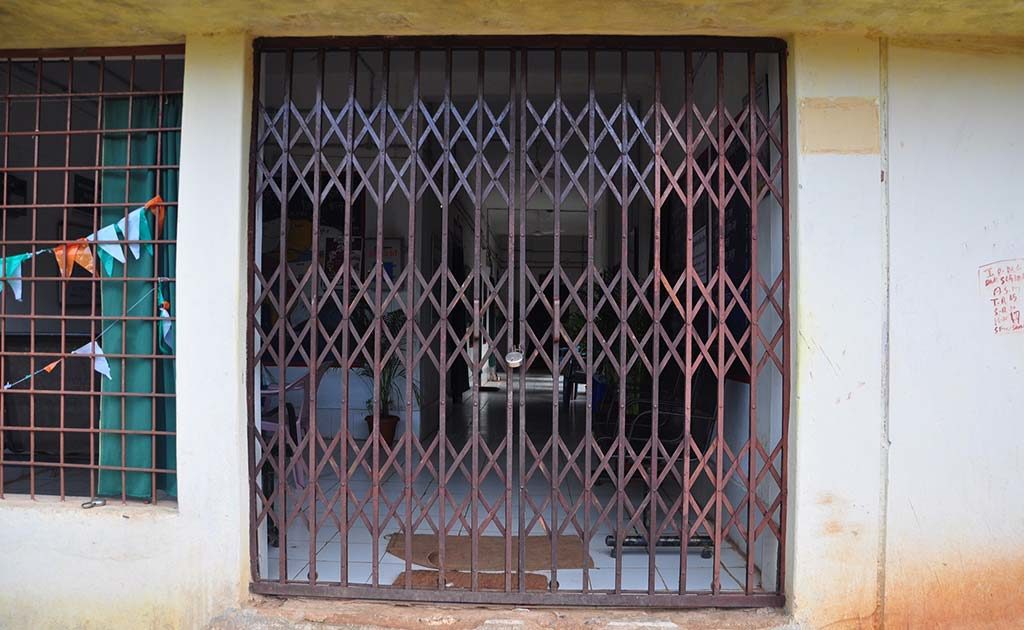
Courtesy: NDTV.
Primary Health Centre in the Jagdalpur district. NDTV was told the Rural Medical Assistant who runs it left at noon. They are supposed to be available until 4 pm (October 12, 2016).
gX: What about health and other services?
KS: Very similar things have happened regarding health services too. They say the Maoists attack the 108 ambulance vehicles. But they never explain why is it that 8 armed personnel got killed in one such attack. Why were armed personnel traveling in an ambulance meant for patients? Now they have stopped the 108 service altogether. Now the question is, what about health centers then? The Maoists never attacked any health center. Why are then the health centers under lock and key? In the seven district hospitals, they can’t even diagnose and treat you. The only thing that they do is refer you to the Raipur hospital. So imagine what would be the condition of village level health centers, even if they happen to exist somewhere.
Let’s consider drinking water, and let’s leave out the forest areas where they say the Maoists are in control. But what about the plain areas? There is a village only 17 km away from Kanker. The school there had 117 students, 4 years back. When I went, I found 97 of them had fluorosis from the drinking water there. This is the overall situation of public service, public administration in Bastar.
Read part 2 here.

